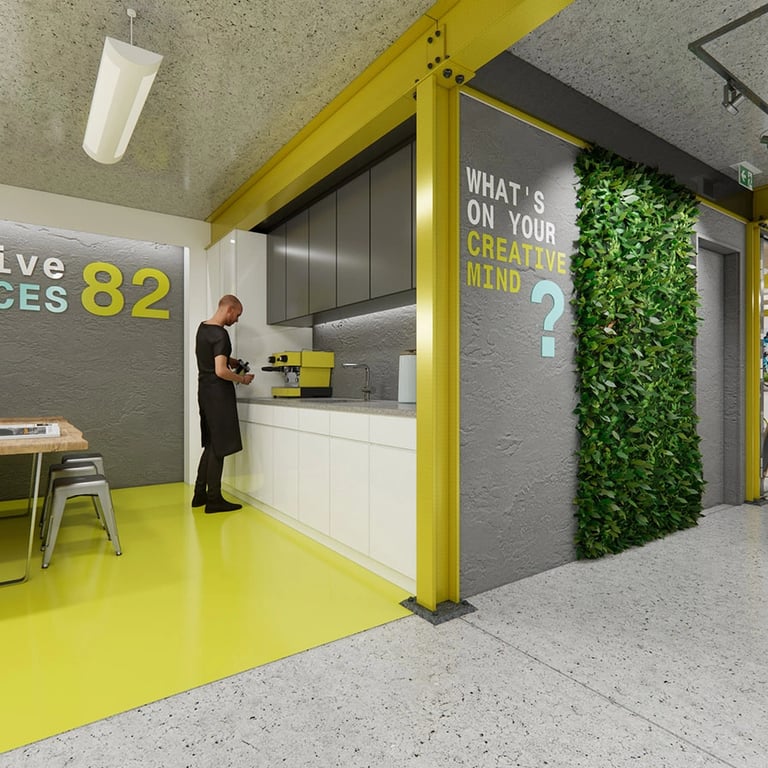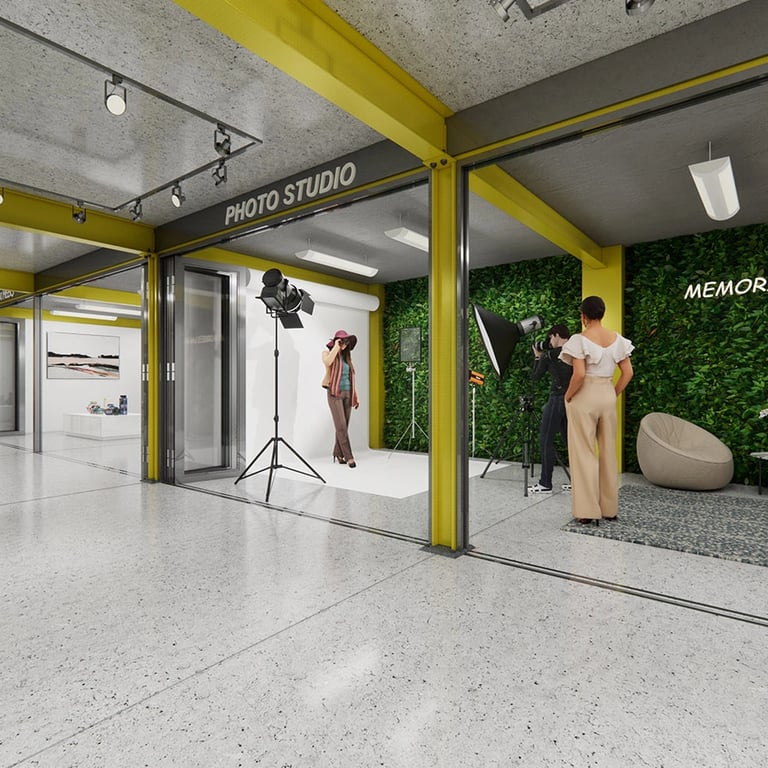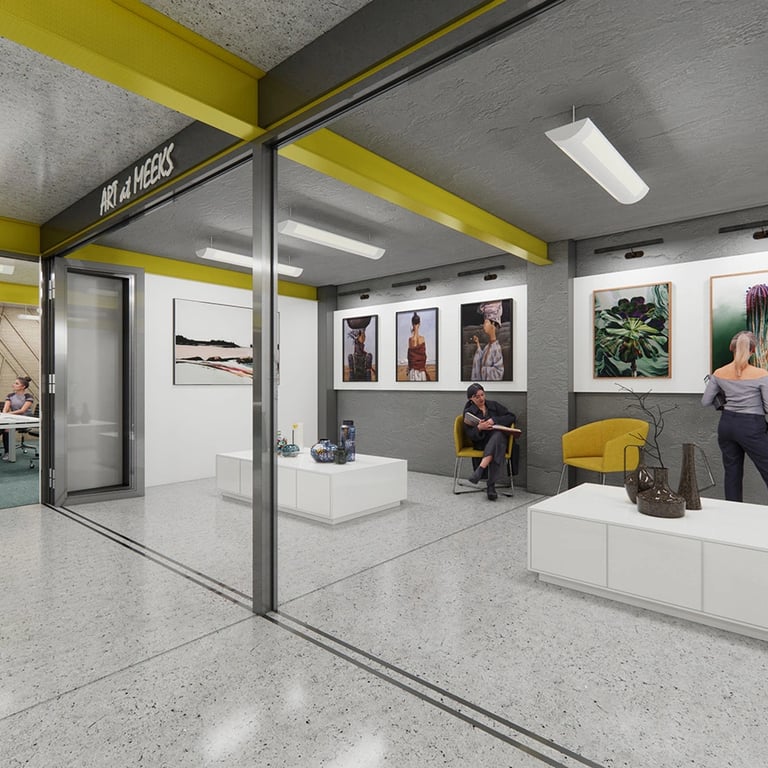


CS82 | Creative Spaces at 82 Meeks Street – A Bold Industrial Transformation in Marrickville
Reimagining Underutilized Space: The Birth of CS82
When a forward-thinking developer approached our architecture studio with a challenge—a raw, semi-basement space at 82 Meeks Street in Marrickville—they saw potential where others saw limitations. The brief was open-ended: "What can we do with this?" The space was cavernous, with exposed concrete, steel columns, and an industrial rawness that begged for reinvention.
Marrickville, a suburb pulsating with creative energy, demanded a solution that resonated with its eclectic mix of artists, makers, entrepreneurs, and small businesses. Our mission? To transform this underutilized shell into a dynamic, flexible hub for creative enterprises—a place where coffee brewers, photographers, architects, bike mechanics, and artists could coexist in a shared ecosystem of innovation.
Understanding Marrickville: A Community-Driven Approach
Before sketching a single line, we immersed ourselves in Marrickville’s culture. The suburb is a melting pot—home to craft breweries, street art, indie music venues, and a thriving small-business scene. We spoke with local creatives, hosted pop-up workshops, and analyzed the area’s demographic shifts. One thing was clear: Marrickville needed more adaptable, affordable spaces for micro-businesses to flourish.
This wasn’t just about architecture—it was about curating an experience. We envisioned a space where:
A barista could experiment with specialty coffee in a sunken lounge.
A bike repair shop could operate alongside a muralist’s studio.
An architect could sketch designs under the glow of industrial pendant lights.
The Design Concept: Industrial Aesthetics Meets Bold Creativity
The design needed to be raw yet refined, utilitarian yet inspiring. We embraced the building’s existing industrial bones—exposed concrete ceilings, steel beams, and unfinished surfaces—but injected vibrancy through bold color blocking and strategic materiality.
Key Design Elements:
Bright Yellow Steel Columns & Beams – A nod to Marrickville’s street art culture, the structural elements were painted in a high-gloss yellow, creating a striking contrast against the raw concrete.
Deep Green Feature Walls – Inspired by the lush inner-west greenery, these walls added warmth and depth to the otherwise industrial shell.
Modular Tenancy Spaces – Each unit was designed for flexibility, with sliding partitions, foldable workbenches, and adaptable lighting rigs to accommodate diverse uses.
Exposed Services as Art – Rather than concealing ducts and pipes, we celebrated them, painting some in accent colors and integrating them into the spatial rhythm.
Coffered Concrete Ceilings – The existing concrete was preserved, with recessed LED strips highlighting its textured imperfections.
Challenges & Innovations: Turning Constraints into Features
Every adaptive reuse project comes with hurdles. Here’s how we tackled them:
1. Low Ceiling Heights & Natural Light
The semi-basement location meant limited sunlight penetration. Our solution?
Light Wells & Reflective Surfaces – We carved out strategic openings to channel natural light inward and used mirrored panels to amplify brightness.
Glazed Partitions – Frosted glass dividers allowed light to permeate deeper into the space while maintaining privacy.
2. Acoustic Control in an Open Plan
With multiple tenants operating simultaneously, sound bleed was a concern. We integrated:
Acoustic Baffles – Suspended felt panels softened noise without compromising the industrial aesthetic.
Textured Wall Panels – Perforated plywood sections doubled as sound absorbers and display surfaces.
3. Budget Constraints
To keep costs low, we maximized existing materials:
Polished Concrete Floors – Instead of new flooring, we diamond-polished the existing slab for a sleek, durable finish.
Salvaged Timber Joinery – Repurposed hardwood from demolished warehouses became custom shelving and counters.
The Final Vision: A Thriving Creative Ecosystem
Today, CS82 stands as a testament to adaptive reuse done right—a space that honors its industrial past while fostering Marrickville’s creative future. The tenants have transformed it into a living, breathing hub:
"The Underground Brew" – A specialty coffee bar with a sunken seating area, where locals gather under the glow of neon signage.
"Gearhead Garage" – A bike workshop where mechanics tinker amidst hanging steel-framed tool boards.
"Lens & Light Studio" – A photographer’s dream, with retractable backdrops and movable light rigs.
"Atelier 82" – An architect’s studio where raw concrete walls serve as pin-up boards for sketches and models.
Why CS82 Matters for Marrickville’s Future
This project wasn’t just about bricks and mortar—it was about activating dead space, supporting local enterprise, and fostering unexpected collaborations. By blending industrial grit with playful design, we created a space that feels both raw and refined, utilitarian and artistic.
For developers and architects, CS82 proves that even the most challenging spaces can become vibrant destinations—with the right vision, community insight, and bold design choices.
Looking for Adaptive Reuse Architects in Sydney?
If you have an underutilized building—a warehouse, basement, or forgotten structure—let’s discuss how to reimagine it into a thriving commercial or creative hub. Our studio specializes in transformative, community-driven architecture that balances aesthetics, functionality, and sustainability.
Designing your future
where innovation meets style, and every space tells your unique story. We blend modern aesthetics with functional design to create spaces that inspire and elevate everyday living.
KENURO architects
KENURO PTY LTD
ABN 22 687 742 132
© 2025. All rights reserved.

Cammeraygal Land
Suite 55 (Level5), 106 High Street, North Sydney, NSW 2060
(T) (02) 8880 0448
KENURO architects acknowledge the Traditional Custodians of country throughout Australia and their connections to land, sea and community. We pay our respect to their Elders past and present and extend that respect to all Aboriginal and Torres Strait Islander peoples today.
